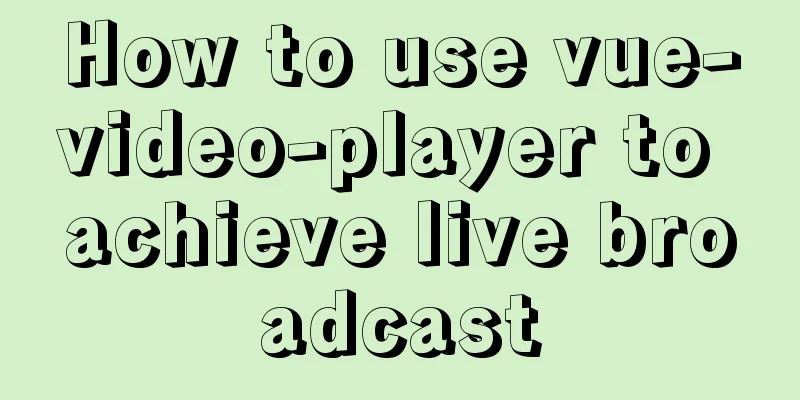How to use vue-video-player to achieve live broadcast

|
Preparation before class: Live streaming protocol https://www.cnblogs.com/yangchin9/p/14930874.html Abstract: Watch live broadcast + video playback on H5 page; During the development, I used plugins such as video.js and mui-player, but found that these video plugins are not friendly to mobile compatibility. Finally, I found a plugin with good compatibility on mobile terminals - vue-video-player Scenario: Mobile H5 page, the project is built with vue, using the HLS protocol and ending with m3u8 live stream 1. Install vue-video-playerTo play HLS video streams, you need to install the videojs-contrib-hls plug-in. To play RTMP video streams, you need to install the videojs-flash plug-in. When the hls plug-in and the flash plug-in are used at the same time, the flash plug-in needs to be introduced before the hls plug-in; (the document says that the hls plug-in will be automatically installed when installing vue-video-player, but it is not in actual operation, so you should install it manually!) Installation method 1:
CDN method, directly introduce the file in the HTML file header:
<link rel="stylesheet" href="path/to/video.js/dist/video-js.css"/>
<script type="text/javascript" src="path/to/video.min.js"></script>
<script type="text/javascript" src="path/to/vue.min.js"></script>
<script type="text/javascript" src="path/to/dist/vue-video-player.js">
</script>
<script type="text/javascript"> Vue.use(window.VueVideoPlayer)
</script>Installation method 2: Click to view the code
NMP installation plugin:
npm install vue-video-player --save
npm install videojs-contrib-hls --save
Introduce the basic style file in main.js:
// Import videoPlayer style import 'video.js/dist/video-js.css'
Import on demand:
import 'videojs-contrib-hls'
import { videoPlayer } from 'vue-video-player'
components:
videoPlayer
},
Global import:
import Vue from 'vue'
import VueVideoPlayer from 'vue-video-player'
// Import custom styles and add the corresponding class name in <video-player>, such as video-player-custom
// import 'vue-video-player/src/custom-theme.css'
Vue.use(VueVideoPlayer, /* {
options: global default configuration,
events: global videojs events}*/)2. Use vue-video-player
<template>
<!-- playsinline: Set the player to not be full screen on mobile devices [ Boolean, default: false ] -->
<!-- customEventName: custom state change event name [String, default: 'statechanged'] -->
<video-player
class="video-player-custom"
ref="videoPlayer"
:options="playerOptions"
:playsinline="true"
customEventName="customstatechangedeventname"
@play="onPlayerPlay"
@pause="onPlayerPause"
@ended="onPlayerEnded"
@ready="playerReadied"
@statechanged="playerStateChanged"
@playing="onPlayerPlaying"
@waiting="onPlayerWaiting"
@loadeddata="onPlayerLoadeddata"
@timeupdate="timeupdate"
@canplay="onPlayerCanplay"
@canplaythrough="onPlayerCanplaythrough">
</video-player>
</template>
<script>
import 'videojs-contrib-hls'
import { videoPlayer } from 'vue-video-player'
export default {
components:
videoPlayer
},
data() {
return {
playerOptions: {
// Is it muted: true,
// The default is English, set to Chinese language: 'zh-CN',
// Playback speed. After specifying it, Video.js will display a control (a control of the vjs-playback-rate class) to allow the user to select the playback speed playbackRates: [0.5, 1.0, 1.5, 2.0],
// Put the player into smooth mode and use this value when calculating the dynamic size of the player, indicating the aspect ratio aspectRatio: '4:3',
// Compatibility order, the default value is ['html5'], other registered technologies will be added after this technology in the order in which they were registered.
techOrder: ['html5'],
// Equivalent to a set of <source> subtags in the native <video> tag, which can achieve graceful degradation; the type attribute specifies the MIME type of the media resource sources: [
//{
//type: "video/mp4",
//src: ""
//},
//{
//type: "rtmp/flv",
//src: ""
//},
{
type: "application/x-mpegURL",
src: "https://live.cgtn.com/1000/prog_index.m3u8"
},
],
// Video cover poster: require('./icon/cover.jpg'),
}
}
},
computed: {
//Plugin node is used to add custom button events player() {
return this.$refs.videoPlayer.player
}
},
mounted() {},
methods: {
// Play callback onPlayerPlay(player) {
},
// Pause callback onPlayerPause(player) {
//console.log(player)
},
//Video playback ends callback onPlayerEnded(player) {
//console.log(player)
},
// readyState changes on DOM element cause playback to stop onPlayerWaiting(player) {
//console.log(player)
},
// Playback has started callback onPlayerPlaying(player) {
//console.log(player)
},
// When the player downloads data at the current playback position, onPlayerLoadeddata($event) is triggered {
//console.log($event)
},
// Triggered when the current playback position changes.
onPlayerTimeupdate($event) {
//console.log($event)
},
//The media's readyState is HAVE_FUTURE_DATA or higher onPlayerCanplay($event) {
//console.log($event)
},
// The media's readyState is HAVE_ENOUGH_DATA or higher. This means that the entire media file can be played without buffering.
onPlayerCanplaythrough($event) {
//console.log($event)
},
//Playback status change callback playerStateChanged($event) {
//console.log($event)
},
//Bind a listener to the component's ready state. The difference with event listeners is that if the ready event has already occurred, it will trigger the function immediately. .
playerReadied($event) {
//console.log($event)
},
}
}
</script>
<style lang="scss" scoped>
.video-player-custom{
width: 100%;
height: 180px;
// vidoeUI rewrites /deep/ .video-js{
width: 100%;
height: 100%;
padding: 0;
overflow: hidden;
// player.vjs-tech{
object-fit: cover;
}
// Play button.vjs-big-play-button {
position: absolute;
top: 50%;
left: 50%;
width: 2em;
height: 2em;
margin-top: -1em;
margin-left: -1em;
font-size: 2em;
line-height: 2em;
border-radius: 50%;
background-color: rgba(0,0,0,0.45);
outline: none;
}
// Cover.vjs-poster{
width: 100%;
height: 100%;
background-size: cover;
}
}
}
</style>This is the end of this article about using vue-video-player to achieve live broadcast. For more relevant vue-video-player live broadcast content, please search 123WORDPRESS.COM's previous articles or continue to browse the following related articles. I hope everyone will support 123WORDPRESS.COM in the future! You may also be interested in:
|
<<: Neon light effects implemented with pure CSS3
>>: HTML n ways to achieve alternate color code sample code
Recommend
JavaScript anti-shake and throttling explained
Table of contents Stabilization Throttling Summar...
Implementation steps for building Webpack5-react scaffolding from scratch (with source code)
Table of contents webpack5 Official Start Buildin...
How to eliminate the extra blank space at the bottom of the created web page when browsing
When using Dreamweaver or FrontPage to create HTM...
React sample code to implement login form
As a Vue user, it's time to expand React. Fro...
Introduction to the use of em in elastic layout in CSS3: How many pixels is 1em?
I have been using CSS for a long time, but I have...
Some improvements in MySQL 8.0.24 Release Note
Table of contents 1. Connection Management 2. Imp...
Implementation of multi-site configuration of Nginx on Mac M1
Note: nginx installed via brew Website root direc...
Pure CSS to implement iOS style open and close selection box function
1 Effect Demo address: https://www.albertyy.com/2...
DELL R730 server configuration RAID and installation server system and domain control detailed graphic tutorial
Recently, the company purchased a DELL R730 serve...
Detailed explanation of the six common constraint types in MySQL
Table of contents Preface 1.notnull 2. unique 3. ...
CentOS7 deploys version 19 of docker (simple, you can follow it)
1. Install dependency packages [root@localhost ~]...
dl, dt, dd list label examples
The dd and dt tags are used for lists. We usually...
Basic statements of MySQL data definition language DDL
MySQL DDL statements What is DDL, DML. DDL is dat...
Solve the problem of running jupyter notebook on the server
Table of contents The server runs jupyter noteboo...
Implementation example of uploading multiple attachments in Vue
Table of contents Preface Core code File shows pa...









